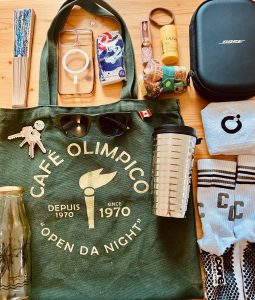Keys, Phone, Headphones
This short ASMR-style audio piece remediates my “What’s in my bag” task into sound. Inspired by Ong’s (1982) notion of secondary orality, I wanted the piece to rely on rhythm, texture, and tone rather than on visuals or text. The aural form conveys intimacy and connection, qualities of communication that Ong describes as characteristic of oral culture but now reborn in digital environments.
Dobson and Willinsky (2009) view digital literacy not as a break from print but as an evolution that extends traditional practices into new media. My piece embodies that idea: I first wrote a script, then transformed it through sound design and recording, blending literacy and orality.
In line with Postman’s (1992) claim that new technologies reorganize our interests and community, the phone segment reflects how handheld media reshape how we navigate daily life—combining payment, communication, and access in one small device. Like McLuhan’s (1967) “classroom without walls,” this audio moves beyond written boundaries, using sound to explore how everyday objects tell stories about belonging and connection.
Accessibility Note
This audio piece contains environmental sounds such as keys jingling, door latch clicks, light tapping on glass, notification tones, and footsteps walking on dry leaves.
All sounds are soft and consistent in volume; there are no sudden or loud noises.
References
Dobson, T., & Willinsky, J. (2009). Digital literacy. In D. R. Olson & N. Torrance (Eds.), The Cambridge handbook of literacy (pp. 286–312). Cambridge University Press.
McLuhan, M. (1967). Classrooms without walls. In E. Carpenter & M. McLuhan (Eds.), Explorations 7 (pp. 119–123). Dial Press.
Ong, W. J. (1982). Orality and literacy. Methuen.
Postman, N. (1992). Technopoly: The surrender of culture to technology. Knopf Doubleday.

Transcript
[0 seconds]
Narration: “Three things I don’t leave home without.”
[4 seconds]
[SFX] clock ticking as Edvard Grieg’s “Peer Gynt – Morning Mood” plays softly in the background.
[9 seconds]
[SFX] Alarm clock beeps while music continues to play softly in background
[16 seconds]
Narration: “Let’s start our day together.”
[18 seconds]
[SFX] door opens and closes
[22 seconds]
[SFX] keys jingling
[26 seconds]
[SFX] door locking
[29 seconds]
[SFX] Morning sound of birds singing and footsteps on dry autumn leaves
Narration: “My keys remind me of where I belong. Every key fits a place that’s all mine.”
[38 seconds]
[SFX] Sound of an incoming text message dinging
Narration:“It’s not just my phone. It’s my currency, how I pay for things, how I stay connected through messages and emails, how I navigate my way through the city using it as a map. I can access any book or song ever made with the tap of my finger on glass.”
[1 minute 03 seconds]
[SFX] Light typing sound; soft glass taps.
[1 minute 12 seconds]
[SFX] Swoosh of a sent email
Narration: “Message sent.”
[1 minute 17seconds]
[SFX] Headphone case being unzipped
[1 minute 22 seconds]
Narration: “Headphones connected.”
[SFX] Bluetooth connection sound
[1 minute 29 seconds]
[SFX] Harmonica intro from Bruce Springsteen’s “Thunder Road” begins to play in background
Narration:“Headphones on. The world softens. Music finds me. Old songs from car trips of my childhood come rushing back. Stories I still carry.”
[1 minute 44 seconds]
Narration: “No wallet, no watch. Somehow I have everything I need.”
 I almost never write by hand anymore, though I used to when I was younger. I was born in 1978 so computers were not part of my elementary or really even high school education. My handwriting has always been terrible, but I always felt that when writing by hand, there exists a strong connection between my thoughts and the way they spill onto the page. Unfortunately, my brain works faster than my hand can keep up, which only makes my penmanship look even worse. Over time, as I have become a better typist, I have learned to develop a similar connection between my mind and the keyboard. However,
I almost never write by hand anymore, though I used to when I was younger. I was born in 1978 so computers were not part of my elementary or really even high school education. My handwriting has always been terrible, but I always felt that when writing by hand, there exists a strong connection between my thoughts and the way they spill onto the page. Unfortunately, my brain works faster than my hand can keep up, which only makes my penmanship look even worse. Over time, as I have become a better typist, I have learned to develop a similar connection between my mind and the keyboard. However,